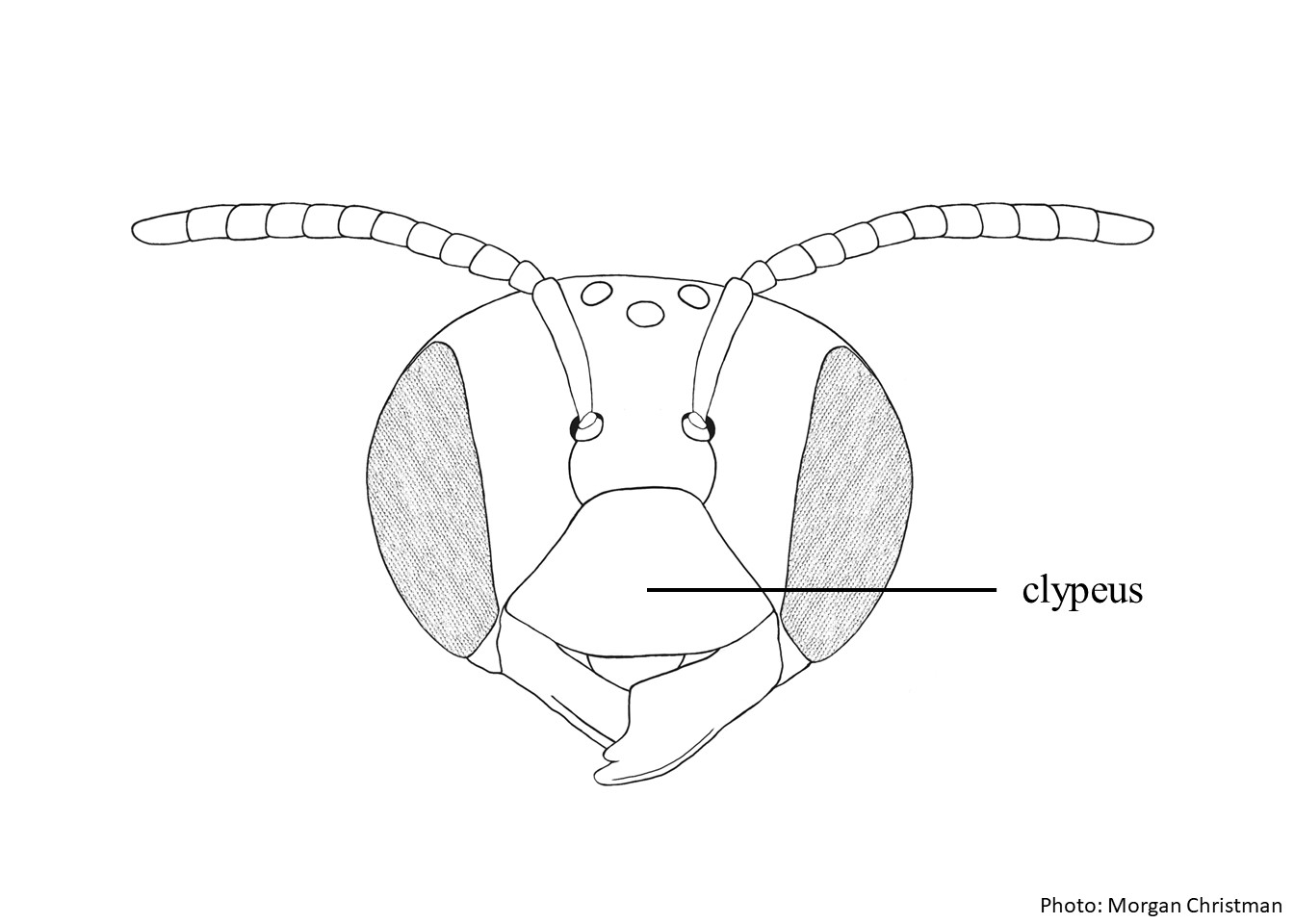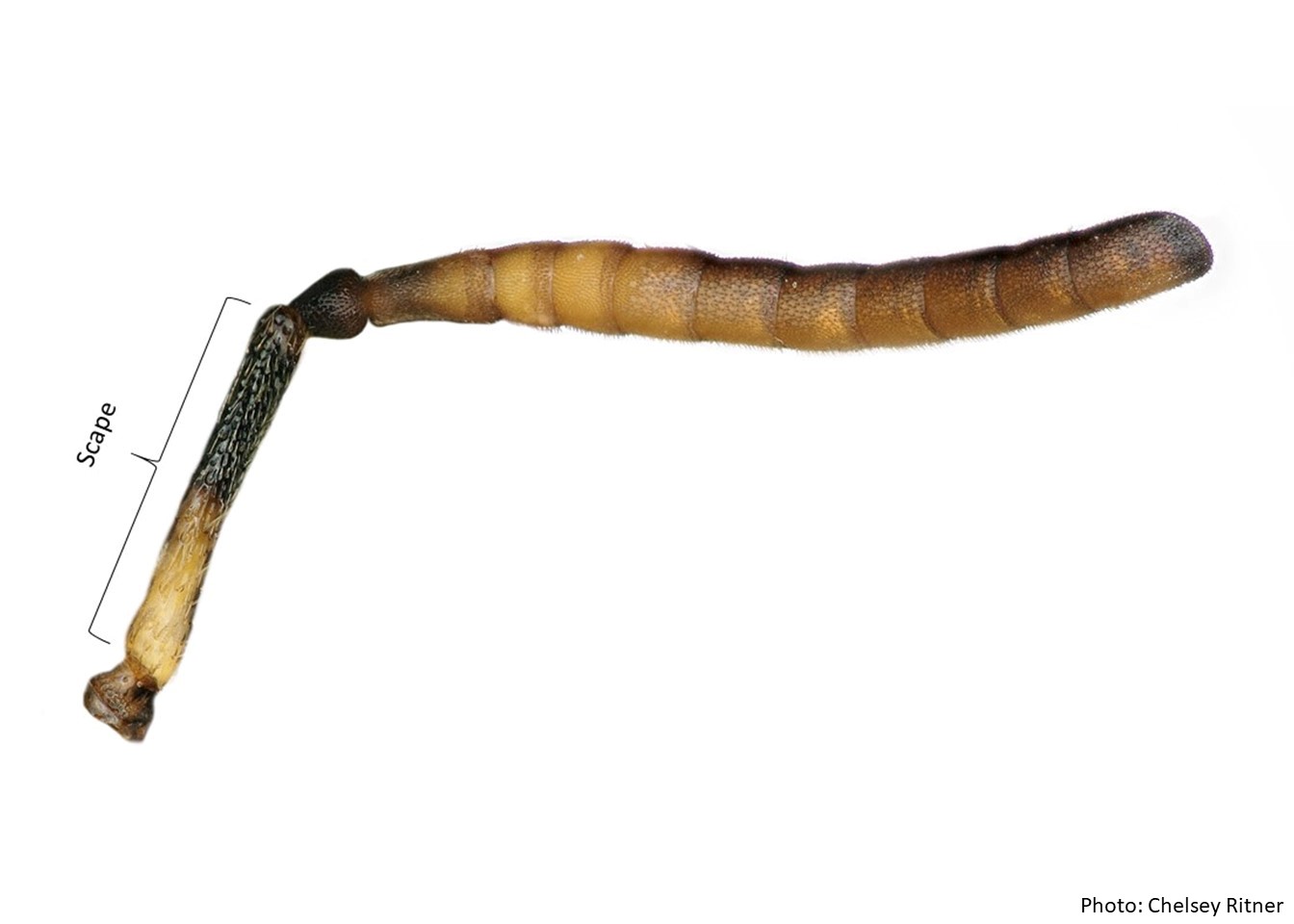Taxonomy
Family: Apidae
Subfamily: Apinae
Tribe: Apini Latreille, 1802
Genus: Apis Linnaeus, 1758
Subgenus: Apis (Apis) Linnaeus, 1758
Species: Apis nigrocincta Smith, 1861
Common names: none
Overview
Apis nigrocincta was resurrected after work by Hadisoesilo, et al. (1995) with discriminant analysis of different species of honey bee of Sulawesi, Indonesia. In this study, the authors found a group of bees different from A. cerana and A. koschevnikovi, and after further comparison with type material found that these bees were more similar to the holotypeholotype:
the type specimen used to describe a species
of A. nigrocincta described by Smith (1861). In addition to morphological differences, A. nigrocincta is also the only known host of the parasitic mite Varroa underwoodi, and studies on drone flight times also support the status of A. nigrocincta as a separate species from Apis cerana (Hadisoesilo and Otis 1996Hadisoesilo and Otis 1996:
Hadisoesilo S. and G.W. Otis. 1996. Drone flight times confirm the species status of Apis nigrocincta Smith, 1861 to be a species distinct from Apis cerana F, 1793, in Sulawesi, Indonesia. Apidologie 27 (5) 361ndash;369., 1998; Otis et al. 2001Otis et al. 2001:
Otis, G.W, S. Hadisoesilo, C. Sugiyani, and A.M. Cooper. 2001. Using social bees as indicators of habitat quality in Sulawesi, Indonesia. In: Proceedings of the 7th International Conference on Tropical Bees, Chiang Mai. Pp: 313ndash;317.).
Diagnostic characteristics
- Hind wing with distaldistal:
place on a segment that is furthest from the place of attachment with the body
abscissaabscissa:
veins that help define wing cells
of vein M absent.
- Mesoscutellum yellow-brown, very rarely black (Fig 5 and 7).
- Drones without metabasitibial process.
- Body size moderate (forewing length between 7–9 mm).
- Clypeus clypeus:
a section of the face below the antennae, demarcated by the epistomal sutures
 rusty yellowish (Fig 1 and 4).
rusty yellowish (Fig 1 and 4).
- Antennal scapescape:
the basal, and usually the longest, segment of the antennae
 reddish-brown (Fig 1, 4, and 7).
reddish-brown (Fig 1, 4, and 7).
- Legs reddish-brown (Fig 2 and 6).
- Pubescence pubescence:
short, fine hair
of body reddish-tan.
Host associations
As with all species of honey bees, A. nigrocincta is generalist and visits a broad range of plants for food.
Nesting behavior
A. nigrocincta nest in cavities. Compared with other species in the subgenus Apis, this species produces more drones under normal conditions. Very little else is known about this species' nesting behavior.
More recently, Hadisoesilo and Otis (1998) showed that the capping of the drone cells in A. nigrocincta lack the pore (the drone cell has a narrow opening, without hard wax cap and with a hole) that is present in drone’s cells of Apis cerana.
Diversity
To the present, there is no information regarding any variation among the different populations of A. nigrocincta, but due to the restricted distribution of the species in Southesast Asia, it is very likely that it’s a uniform species.
In terms of the internal anatomy, Chaiyawong, et al. (2001) showed differences in the morphology of the sting apparatus of A. nigrocincta when compared with those of A. cerana.
Distribution
This species is restricted to Indonesia and the Philippines (Otis 1996Otis 1996:
Otis, G.W. 1996. Distributions of recently recognized species of honeybees (Hymenoptera: Apidae: Apis ) in Asia. Journal of the Kansas Entomological Society 69: 311ndash;333., Damus and Otis 1997Damus and Otis 1997:
Damus M.S. and G.W. Otis. 1997. A morphometric analysis of Apis cerana F. and Apis nigrocincta Smith populations from Southeast Asia. Apidologie 28 (5): 309ndash;323., Radloff et al. 2011Radloff et al. 2011:
Radloff, S.E., H.R. Hepburn, and M.S. Engel. 2011. The Asian species of Apis . In: Hepburn, H. R. amp; S. E. Radloff (eds.). 2011. Honeybees of Asia. Springer-Verlag, Berlin. Chapter 1. Pp. 1ndash;22.): specifically Sulawesi (Indonesia), Mindanao, and Sangihe (Philippines).

Distribution map generated by Discover Life -- click on map for details, credits, and terms of use.
References
Damus M.S. and G.W. Otis. 1997. A
morphometricmorphometric:
from the Greek: "morph," meaning "shape," and "metron," meaning "measurement." Different schools of morphometrics are characterized by what aspects of biological "form" they are concerned with, what they choose to measure, and what kinds of biostatistical questions they ask of the measurements once they are made; such as configurations of landmarks from whole organs or organisms analyzed by appropriately invariant biometric methods (covariances of taxon, size, etc.) and in order to answer biological questions. Another sort of morphometrics studies tissue sections, measures the densities of points and curves, and uses these patterns to answer questions about the random processes that may be controlling the placement of cellular structures. A third, the method of "allometry," measures sizes of separate organs and asks questions about their correlations with each other and with measures of total size. There are many others.</p
analysis of
Apis cerana F. and
Apis nigrocincta Smith populations from Southeast Asia. Apidologie 28(5):309-323.
Hadisoesilo S., G.W. Otis, and M. Meixner M. 1995. Two distinct populations of cavity –nesting honeybees (Hymenoptera: Apidae) in South Sulawesi, Indonesia. Journal of the Kansas Entomological Society 68: 399-407.
Hadisoesilo S., G.W. Otis G.W., M. Meixner. 1998. Differences in drone cappings of
Apis cerana and
Apis nigrocincta. Journal of Apicultural Research 37:11-15.
Hadisoesilo S. and G.W. Otis… 1996. Drone flight times confirm the species status of
Apis nigrocincta Smith, 1861 to be a species distinct from
Apis cerana F, 1793, in Sulawesi, Indonesia. Apidologie 27 (5) 361-369.
Hadisoesilo S. and G.W. Otis. 1998. Differences in drone cappings
of Apis cerana and
Apis nigrocincta. Journal of Apicultural Research 37:11-15.
Chaiyawong T., S. Jayasvasti, G. Suwannapong, and S. Wongsiri. 2001. Scanning electron microscopic analysis of honey bees,
Apis nigrocincta,
A. cerana,
A. koschevnikovi and
A. mellifera stings. In Wongsiri, S. (ed.), Proceedings of the Seventh International Conference on Tropical Bees: Management and Diversity & Fifth Asian Apicultural Association Conference 19-25 March, Thailand. pp. 121-128.
Keeling C., G.W. Otis, S. Hadisoesilo, and K. Slessor. 2001.
Mandibularmandibular:
near the mandible
gland component analysis in the head extracts of
Apis cerana and
Apis nigrocincta. Apidologie 32 (3): 243-252.
Otis, G.W. 1996. Distributions of recently recognized species of honeybees (Hymenoptera: Apidae: Apis) in Asia. Journal of the Kansas Entomological Society 69:311-333.
Otis, G.W, S. Hadisoesilo, C. Sugiyani, and A.M. Cooper. 2001. Using social bees as indicators of habitat quality in Sulawesi, Indonesia. In: Proceedings of the 7th International Conference on Tropical Bees, Chiang Mai. Pp: 313-317.
Radloff S. E., H.R. Hepburn, and M. S. Engel. 2011. The Asian species of
Apis. In: Hepburn, H. R. & S. E. Radloff (eds.). 2011. Honeybees of Asia. Springer-Verlag, Berlin. Chapter 1. Pp. 1-22.
Raffiudin R. and R.H. Cozier. 2007. Phylogenetic analysis of honeybee behavioral evolution. Molecular Phylogenetics and Evolution 43: 543-552.
Smith, F. 1961. Descriptions of new species of hymenopterous insects collected by A. R. Wallace at Celebes. Proceedings of the Linnaean Society of London. 5:57-93.
Smith D.R., L. Villafuerte, G.W. Otis G., and M. Palmer. 2000. Biogeography of
Apis cerana F. and
A. nigrocincta: insights from mtDNA studies. Apidologie 31(2): 265-279.
Takahashi J-I., J. Nakamura, M. Sasaki, S. Tingek, and S.I. Akimoto. 2002. New haplotypes for the non-coding region of mitochondrial DNA in cavity-nesting honey bees
Apis koschevnikovi and
Apis nuluensis. Apidologie 33(1): 25-31.
 reddish-brown (Fig 1, 4, and 7).
reddish-brown (Fig 1, 4, and 7).